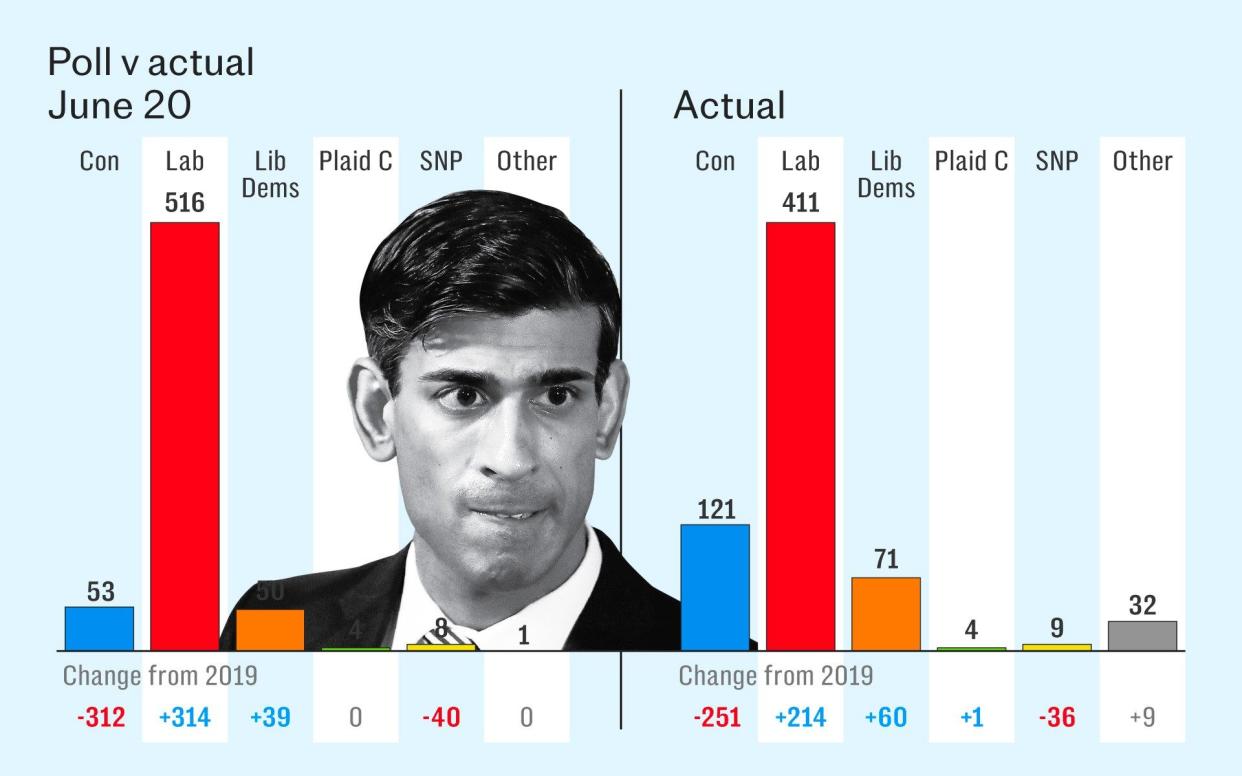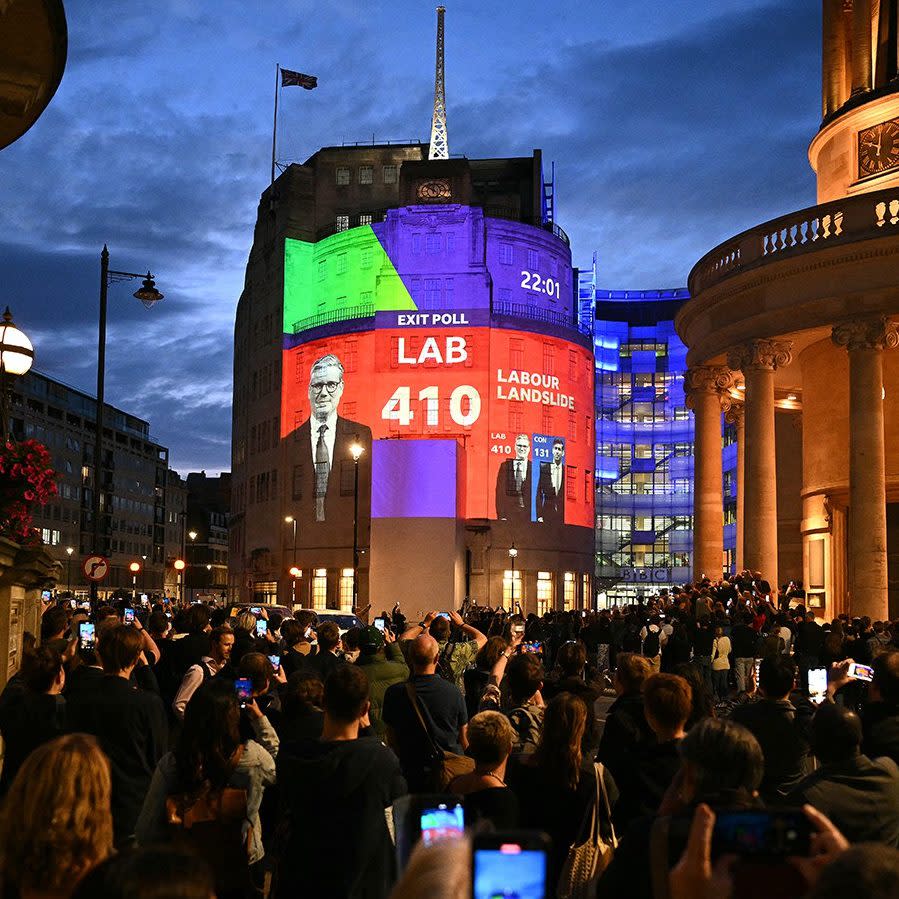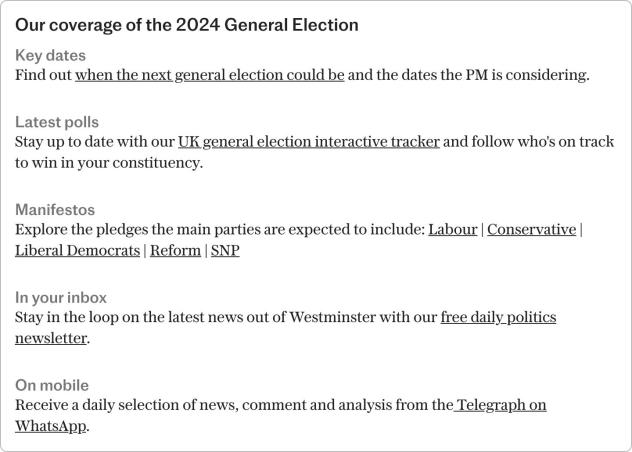Why pollsters overstated Labour’s victory

Pollsters overestimated the scale of the Labour victory by as many as 60 seats in the run-up to Thursday’s general election, official results show.
Final estimates earlier this week for the Tories varied from less than 50 seats to more than 126. Labour saw a similarly wide range, with forecasts from 430 to 480.
For the Conservatives, the election was fought against a backdrop of cataclysmic polling. In the final days of campaigning, the Tories warned that a vote for Labour would lead to a “supermajority” or, as Boris Johnson put it, a “sledgehammer majority”. Rishi Sunak insisted the result was not a “foregone conclusion”.
The Conservatives’ performance was ultimately better than projected, with 121 seats, while Labour’s victory was overestimated, with 410 seats gained.
Sir Keir Starmer’s majority of 172 seats is smaller than Sir Tony Blair’s record-breaking 179-seat majority in 1997, but larger than the party’s 2001 win.
Pollsters base their forecasts on surveys and a range of demographic data including estimated voting intention and turnout. The differing forecasts could be explained by a very slight overestimation of the Labour vote which could have resulted in a significant readjustment of seat numbers.
Polling firm More in Common was the most accurate, forecasting Conservative, Liberal Democrat and SNP seats within ten seats of their best estimate, compared to the final results. Their polling suggested the Conservatives would land 126 seats.
This was better than JL Partners, Survation and YouGov, which were out by up to 30 seats. In June, a few weeks before election day, Savanta forecast just 53 seats for the Tories.
All pollsters consistently overestimated Labour’s performance, with five of the nine major firms suggesting it would win more than 450 seats.
Survation was the most accurate when it came to third parties, predicting 61 seats for the Lib Dems, and was the only pollster to suggest more than a handful of seats for Reform UK.
The firm projected seven seats for Nigel Farage’s party, but Reform won only 4.
Almost all pollsters projected the collapse of the SNP, but not necessarily to the extent of the nine seats they currently have. They are still disputing the constituency of Inverness, Skye and West Ross-shire, expected to declare on Saturday.
Polling groups also provide voting intention data, which estimates the vote share of each party.
The latest of these forecasts put Labour on 41 per cent of the national vote share, ahead of Conservatives on 21 per cent, Reform on 15 per cent and the Lib Dems on 11 per cent.
The reality is slightly better for the Conservatives, but they are still facing their worst ever result by a considerable margin.
The seat forecasts are generally put out by pollsters using a method called multilevel regression with poststratification (MRP).
This involves surveying thousands of individuals, with efforts made to capture a decent sample size in as many constituencies as possible. Results are then adjusted across all seats in the UK, taking into account demographics, previous voting trends and estimated turnout.
Forecasters will run hundreds of versions of these analyses, slightly tweaking variables such as turnout or voting intention. They will then produce constituency-level estimates based on the average outcome of these simulations.
Most pollsters also publish higher and lower estimates based on those different simulations, with the gaps often being considerable.
JL Partners, for example, which released its forecast on July 2, had a higher estimate for the Conservatives of 139 and lower estimate of 81 – a gap of 58 seats. Its upper estimates for Reform were also correct.
However, it was one of the few pollsters to factor that into its figures.

YouGov suggested that as few as 391 Labour seats could be won, one of the few firms to do so.
One of the clear signs from all the polling data is that this election will see very narrow margins across seats.
YouGov’s latest MRP, for example, forecast that 38 per cent of MPs would win their seats with less than 40 per cent of the popular vote. This is compared to just 2.5 per cent of MPs in 2019.
The rise of Reform, as well as a strong projected performance from the Greens, mean that these winning vote shares could be at record lows, making many seat forecasts well within the margin of error and too close to call.
It could, in part, help explain the fluctuations in seat forecasts because slightly different methodologies could swing those margins either way.


 Yahoo News
Yahoo News 
